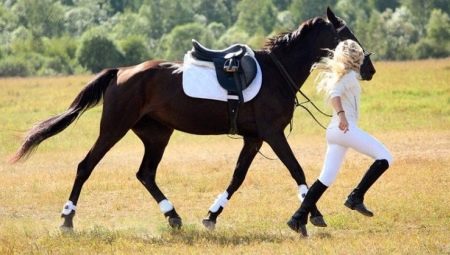The horse on the farm requires special care, so it is so important to provide it with appropriate equipment. If the harness is chosen correctly, taking into account the individual characteristics of the animal, then the process of horse getting used to the owner will be faster.
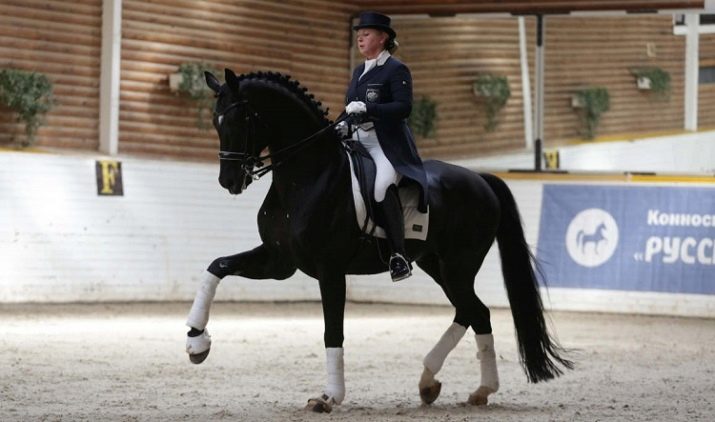
What is needed for management?
Today there is no problem in acquiring high-quality ammunition for a horse, regardless of the area where it is supposed to be used. Halter, bridle, shambon, saddle and other accessories - all this horse harness. Everything you need is in specialized stores. When choosing a kit, you need to understand that any quality horse harness should be universal. It is desirable that some parts can be replaced if necessary.
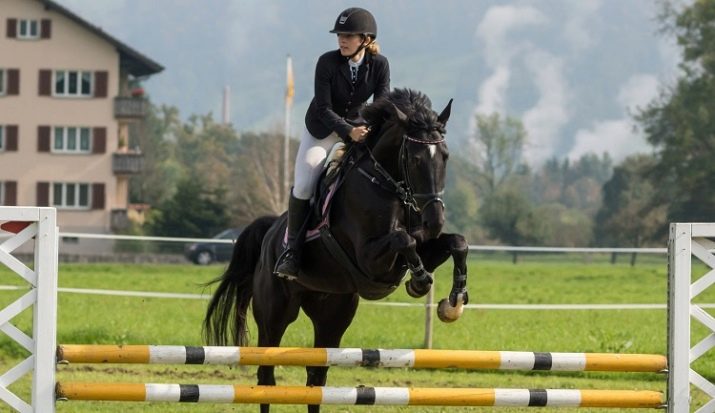
The following items are part of the riding equipment.
- Halter. This device allows you to train a horse. This type of headband is a bridle, but the kit is not complete. It is used to provide the necessary control over the horse or when it is necessary to saddle it. Putting it on, the owner is more comfortable working in the open. At the same time, the animal’s mouth is not busy with anything, so it can graze. The halter consists of a capsule, chin, buccal and occipital belts.
To train especially sensitive horses, use a rope halter. He is soft, does not injure the horse. Round nodules in the structure produce pressure, easily affecting the horse’s skin and causing it to turn its head to where the owner needs it.

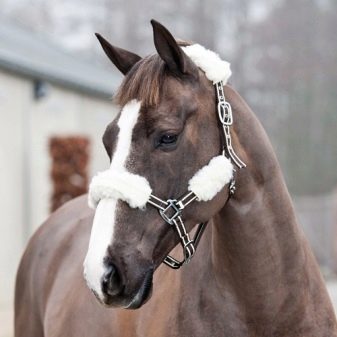
- Stirrups. They are part of the saddle design. The rider needs to put his legs in a fixed position during the ride on the animal.Stirrup allows you to maintain the necessary balance. Many decades ago, this element was in the form of loops, which is not entirely convenient and unsafe.
Today they are made of metal and have a well-thought-out shape.
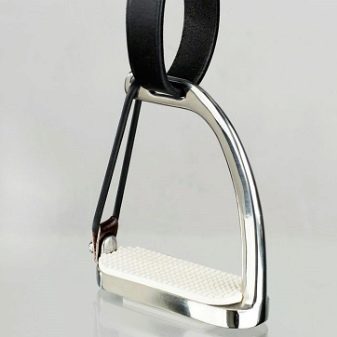

- Bit. Driving a horse is simple, an important role in this is played by the bit. They are inserted into the toothless edge of the gums and allow the animal to rotate. The design is very simple and consists of two rings, nibbled. With a little tension, the animal understands whether it should stop. This item is purchased taking into account the individual characteristics of the horse. Not always attractive design suggests that the bit will suit the horse.
If it does not fit in size, then the animal will feel discomfort, the mouth and cheeks may be injured.

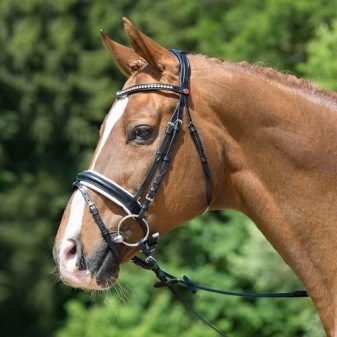
- Whip. Many breeders forget that this device is not basic, but auxiliary when driving a horse. A whip is needed to strengthen the team from the rider, nothing more. In most competitions, you can use it with great restrictions.

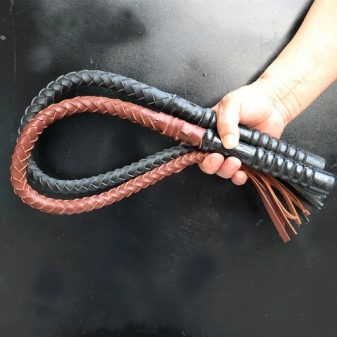
- Putlischi. This element is a small belt through which the stirrup is attached to the saddle. They make it from soft leather, the color may be different. The lock in the design of this product is fixed, its location is lower than human caviar, therefore there is no discomfort during the trip.
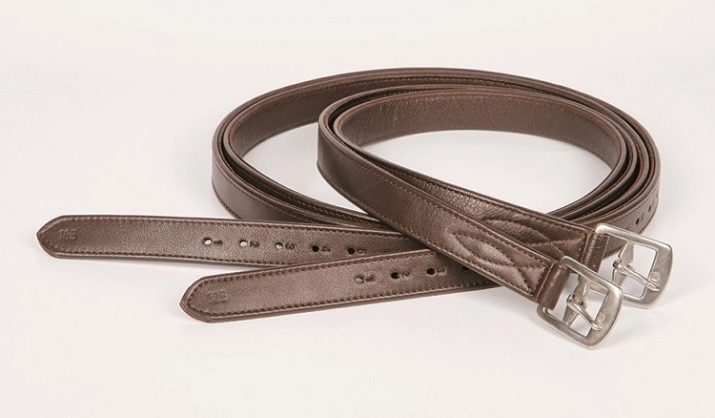
- Saddle bag. More accessory than necessary. It is made of various materials, usually has a rectangular shape so that it lies well on the horse's body.

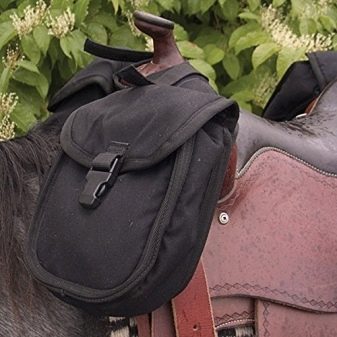
- Occasion. Most often made of leather, as this material perfectly withstands the load. The belt is fastened to the snaffle rings.
Through it, the rider is contacted, controlled and controlled by the animal.
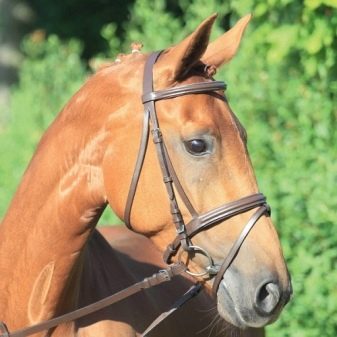
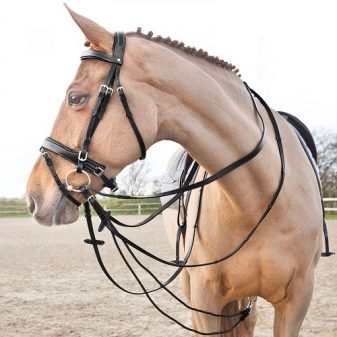
- Martingale. This element does not allow the animal to throw its head up, so the rider is protected from being hit by the head of the horse. They attach the martingale to the girth, in the chest area it is divided into several belts equipped with rings. Reins poke through the rings, limiters are placed closer to the iron.

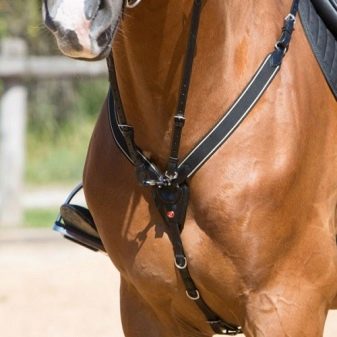
- Chambon. This is one of the interchanges used during the training process. Thanks to her, the head of the animal remains in a fixed position. They attach the element to the iron and cinch, then it lies under the headband, namely, with a cheek strap.
Chambon does not prevent the horse from stretching its head like a martingale, and with its help an extra load is removed from the back of the animal.
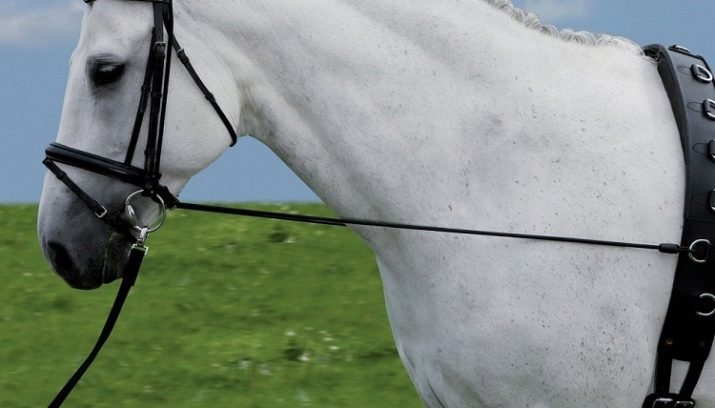
- Saddle. It is used not only for the convenience of the rider, but also to protect the back of the horse. With the right design, the weight of the rider is evenly distributed. For each horse, this part of the ammunition must be selected individually, taking into account the height of the withers of the animal, the length of the lenok and other parameters. Saddles are different: ladies', western, English. Asian saddles and Spanish are on sale. Saddles differ from each other depending on what purpose the horse will be used.
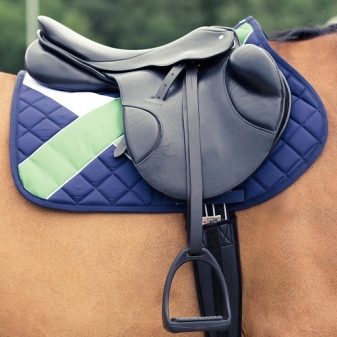
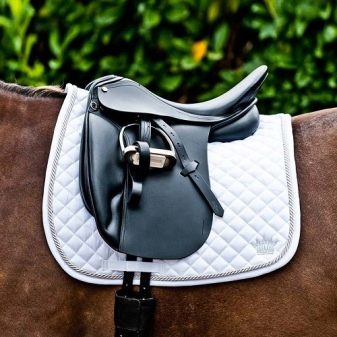
- Spurs. The element that the rider puts on his feet. It is necessary to enhance the impact on the horse. Spurs of various designs are made; recently, those with wheels have been banned from using, since they cause severe harm to the animal.

- Bib. Allows you to provide the necessary safety and stability while driving a horse. This element does not allow the saddle to go back. In order for the bib to perform its tasks, it is necessary to properly adjust it. There are several types: 3- and 5-point, hunting, covering the chest, and competitive elastic.
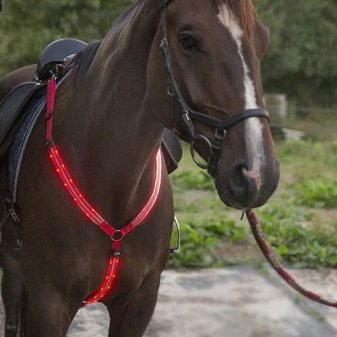

Protective accessories
There is a wide list of horse safety accessories that you must also purchase.
- Hurt. This item is purchased exclusively for cording or hippotherapy. The manufacturer specifically makes an anti-slip coating to make the rider more comfortable. The design is made of leather and steel buckles.
A conveniently located handle helps to stay on the horse.
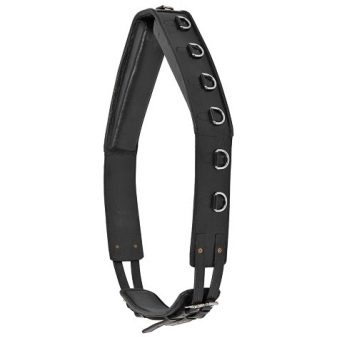
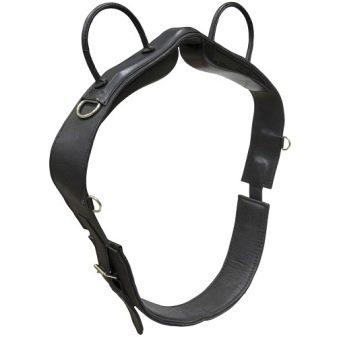
- Blinkers. They are also called shields or eyecups. These are small plates that are installed near the eyes of the animal. They should not only protect them from branches and dirt flying from under the hooves, but also restrict their vision so that the animal does not get scared.
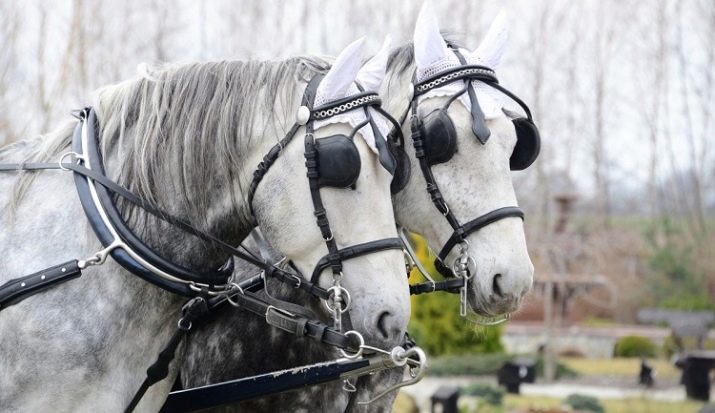
- The forehead. It is part of the bridle. It is needed as a headband holding component that prevents it from slipping. The headband is made in the form of a leather strip, which performs an exclusively working function.
Recently, they began to make beautiful models with color inserts, so that the element also performs an aesthetic function.
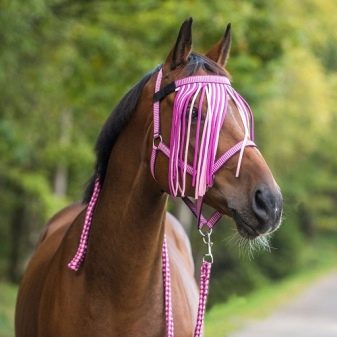
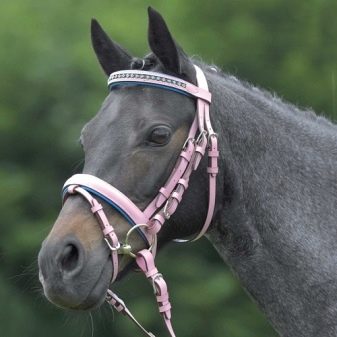
- The undercoat. A very important element of horse equipment, due to which the saddle does not go forward.
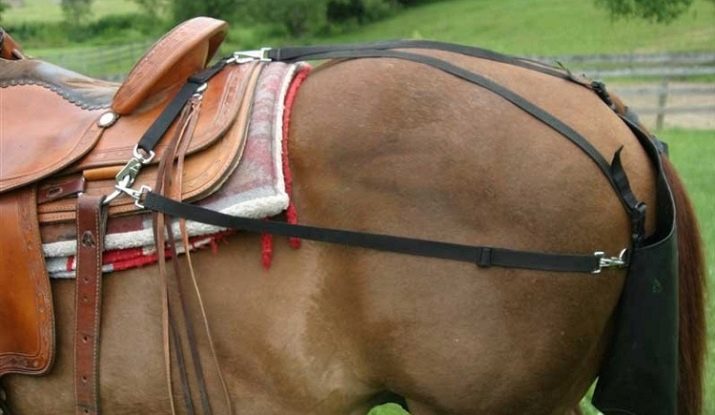
- Blankets. A useful invention that is intended to increase the comfort of the animal. Most often used when the horse is transported in winter, with sudden changes in ambient temperature. In the manufacture of woolen cloth is used, which has a special warming effect. It is fixed with straps and fasteners. A product is sewn taking into account the physiology of the animal and the climatic characteristics of the region. It can be night, walking, winter.
Even the so-called raincoats are made.
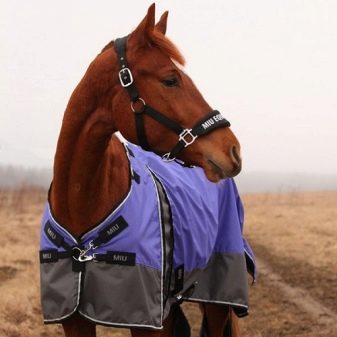
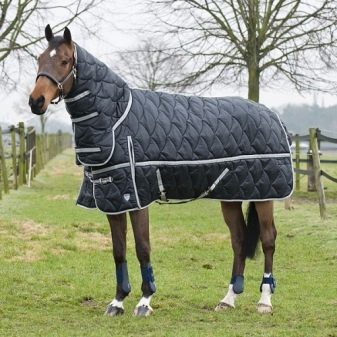
- Bandages The main material that is used when sewing this product is cotton fabric. It is she who is able to provide tendons and joints with appropriate protection. With the onset of cold weather, they are used as a means of insulation. During training, bandages made of knitwear are wound around the horse’s legs, and they can also be crepe. The width of each product is 80 mm.

- Leggings. An accessory that is also used as an animal foot protection. Most often put on over bandages, less often - just on the metacarpus. Fasteners or Velcro fasteners are used.


- Waltrap. This product is placed on the back of the animal in front of the saddle. The main function that the saddle strap performs is protective. It is made of cotton fabric with the subsequent use of filler.
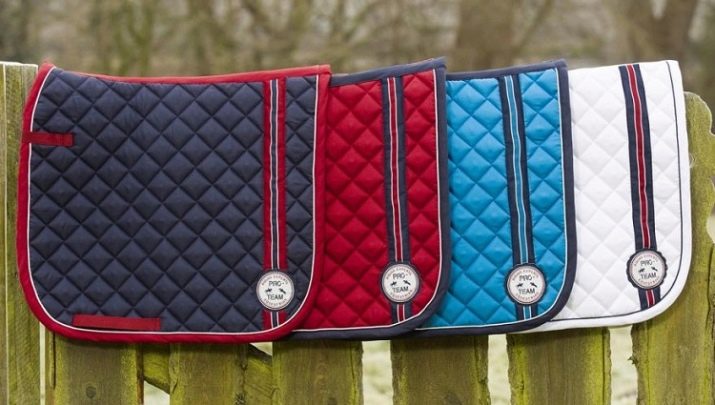
Types of harness
A harness is necessary to provide convenience not only to the rider, but also to the animal. The owner shows that he is in a pair of dominants, harness makes it easy to control the horse, without additional coercion, the animal is under control.
The harness may include blinders on eyes, sometimes they are absent, it all depends on how the animal is used. During competitions, this accessory is of particular importance since helps the horse to focus on the task.
Reins, cinch and other elements are selected individually. More often the owner takes into account the individual characteristics of the horse and other factors. Horse equipment has its own classification, for example, there is a harness for working in the field, sports and competitions, or organizing a cart.
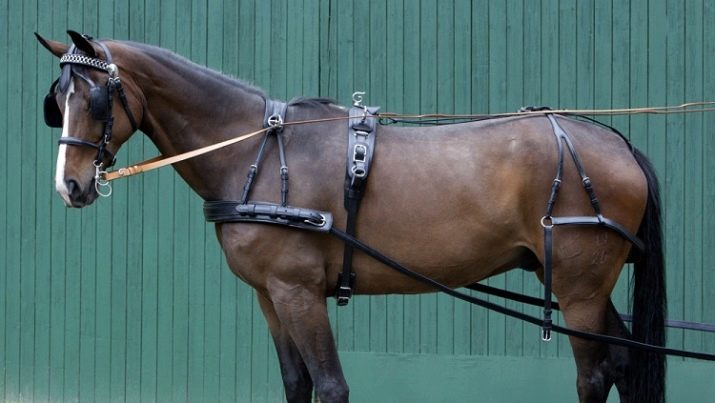
If you take into account the number of harnessed horses, then the harness can be:
- solitary;
- steam room;
- multi-horse, when in one bunch goes from 3 to 8 horses.

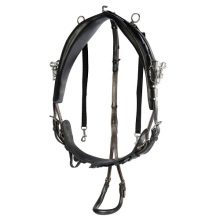
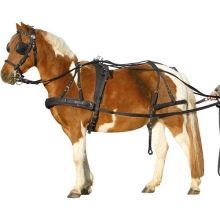
The harness method is also a determining factor and constitutes a separate classification.
- Single-arc. It is easy to guess that only one animal is put in a harness. The design uses a wooden arc, and in addition, horse-drawn vestments.
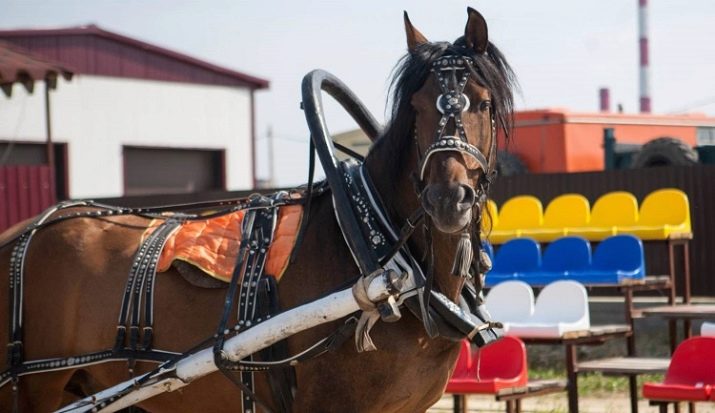
- Shock-witted-edged. The design uses the same elements as in the previous case, only there is no arc. The leading role here is assigned to a larger one, while the shafts are small in size, and they themselves are attached to the saddle, and not to the clamp.

- Linear drawbar. The main role is played by the drawbar, which allows unhindered control of the wagon. With it, the horse easily turns in the right direction. This design can be used not with one, but with two animals at once.
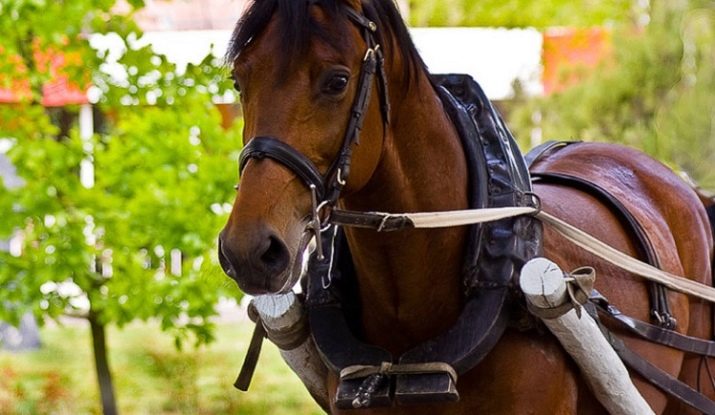
- Line-wise. A simple option in which shafts and an arc are not provided.The whole structure is fixed due to the clamp, as well as the belt system. Often you can find a harness of this type with a hand brake, since it is not easy to make a horse that has accelerated greatly stop by another method.
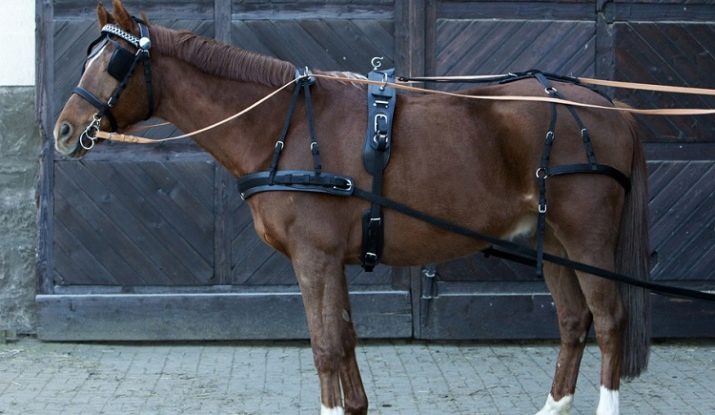
- Tachanochny. The kind of harness that is out of date. It was used to harness 4 horses at a time. In the middle, a pair of horses harnesses using a drawbar, and those located on the sides - through the hem.

- Combined. The main area of destination is harnessing a large number of animals. The design has a construction, deafening and drawbar.

- Zugovoy. Ideal for six horses, four of them are harnessed to the drawbar, the side ones - in the form of a hem.
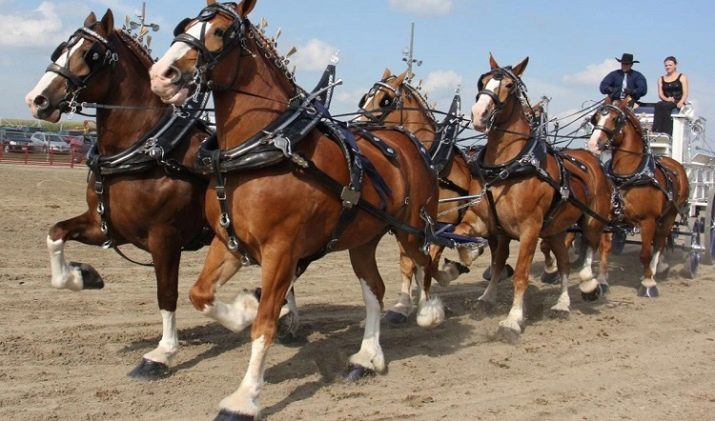
How to choose?
There are basic rules for choosing equipment for a horse, which are worth considering.
- Must be taken into account animal temperament. If the horse is non-aggressive, calm, then you can get thin and hard bit. For active horses it is better to buy soft equipment.
- Clamp not selected by eye, the width and length of the animal along the back must be taken into account. You need to understand that for the harness to the wagon and to perform work in the field, the clamp is used differently.
- By acquiring an arc focus should be on structural strength and resilience.
- Rein can be both integral and composite. The latter are used when several animals are in the cart.
- From qualities the horse’s performance also largely depends on the equipment selected, so you should not save on accessories.
- When buying a yoke to a drawhorse, its weight should be less than that used on the root-horse.

Care Rules
If the owner of the horse watches her harness, then it can last a long time. The better the harness is cleaned, the less likely it is to harm the animal. Given the fact that most elements are made of leather and fabric, the place where they are stored should have an appropriate microclimate.
Inside the pantry or room should not be too wet, as the material quickly undergoes a process of decay. If it is too dry, the skin becomes tough, unpleasant to the touch, it can scratch the skin of the horse. Felt parts are very fond of moths.
To normalize the microclimate, water should be placed in a room where it is too dry and ventilated if excessive humidity is observed.
It is important to carry out and air out the ammunition in spring - this is exactly the time when the moth begins to lay eggs.
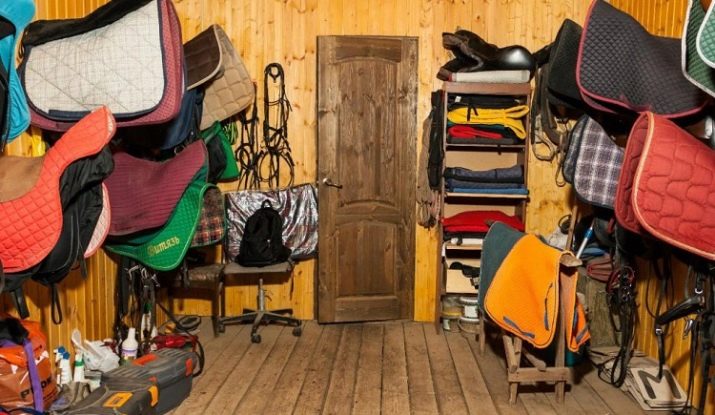
The harness should be not only clean, but also lubricated. From horse sweat and dirt, it hardens, tears. They hang it on wooden structures, but iron hangers are completely unsuitable, since they rust over time and spoil not only the appearance of the equipment.
Particular attention is paid to those elements that are in contact with the body of the animal. After working with the horse, the harness is first cleaned, only after that it is hung to dry. In winter, it can be difficult to do this in the stable, so special dryers are equipped or other, heated storage rooms are used. In the summer, you can simply hang it outside, but it is also important not to dry the leather material, because then it loses its elasticity and quickly breaks.
Felt elements can be tapped with a stick, the girth is softened with your hands. Leather products are specially lubricated so that they do not harden or soak in inclement weather. To do this, you can use special grease, it is allowed to use horse ghee, where birch tar is added. You cannot use solid oil and auto-scrap - they spoil the product.
Grease is applied only after a good cleaning of the harness.
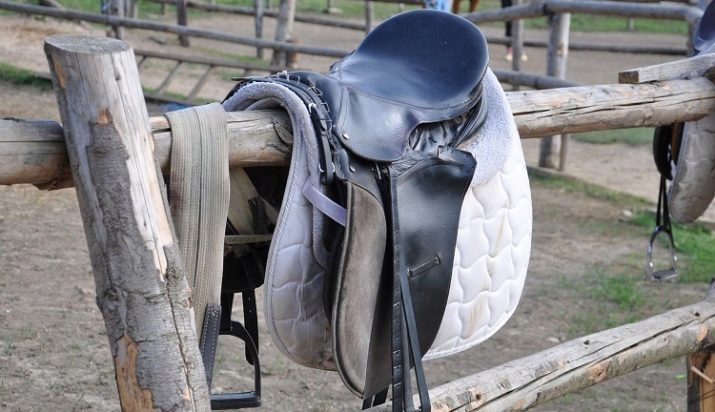
If you need to punch additional holes in the belts, do not do this with an awl or knife. The design will not be affected only if you use a special punch.
Rings, buckles and other metal parts also need to be protected from rust.To do this, they are first wiped with kerosene, then with a dry piece of tissue and then any fat is applied.
Sometimes you may notice that the felt elements are lined with canvas. In this case, after repeated contact with the body of the animal, they become stiff until they are cleaned and dried.
This is why it is important that there are no nodules or coarse seams on the surface, as they can injure the animal.

A review of horse harness see in the next video.
